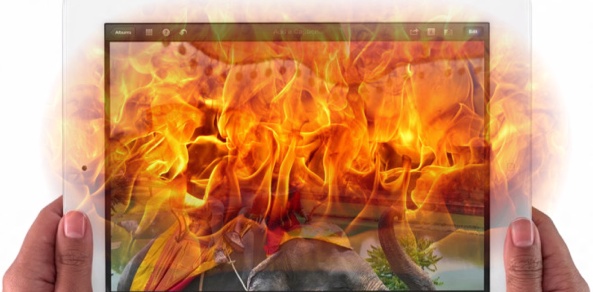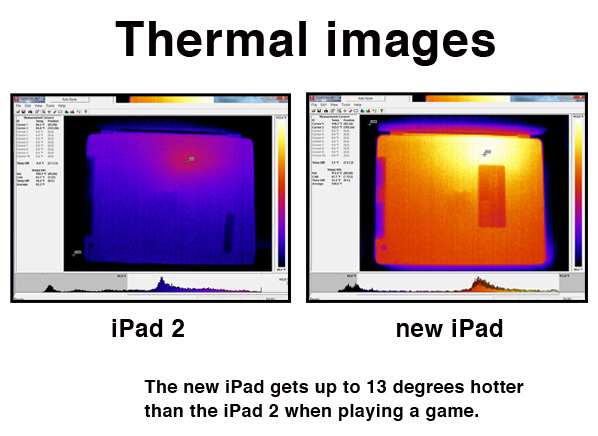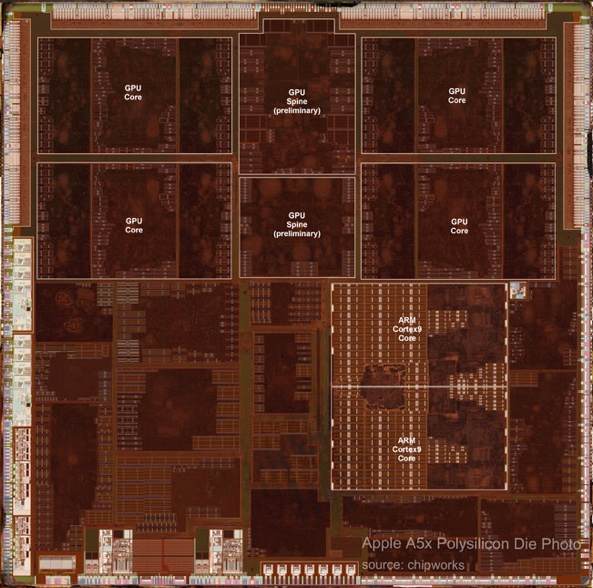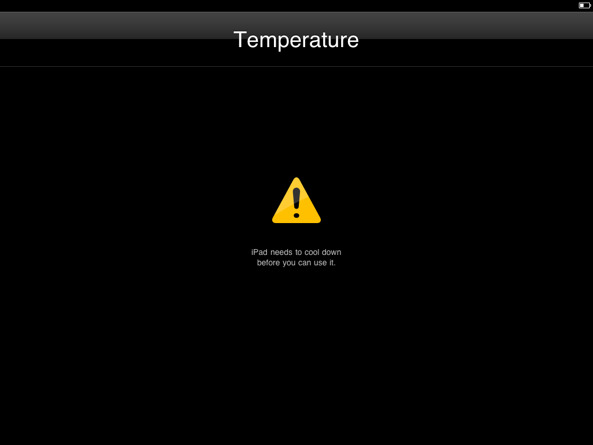Image courtesy of GSM Arena
There’s an awful lot of hoopla around the new iPad overheating. People are getting spooked by heat maps and that screenshot of standard iOS prompt saying “the iPad needs to cool down” average users rarely see. It goes without saying that the press immediately jumped on the opportunity to exploit the story in order to keep those eyeballs glued to the screen.
And with Consumer Reports now throwing its credibility behind Heatgate, it’s easy to walk away under the impression that the new iPad comes with a major hardware flaw. Now, If you ever held a PS Vita, you can attest it runs a lot hotter than the iPad.
Still, it’s hard to escape the notion the story is gaining traction because it’s about the world’s most powerful technology corporation that just released the third iteration of its category-defining gizmo everyone wants (it’s selling like hotcakes). Yes, the new iPad is a bit toastier than its predecessor – full five degrees Celsius to be precise.
How exactly is this a big deal, you ask. Here’s why the new iPad gets hotter, why it doesn’t matter and how it’s being blown out of proportion…
First things first. Thermal imaging has pegged the hottest spot on the new iPad at 92.5 degrees Fahrenheit, translating to 33.6 degrees Celsius. Heat maps also show its predecessor, the iPad 2, clearly running cooler at 82.9 degrees Fahrenheit, or 28.3 degrees Celsius. So yes, the new iPad runs gets noticeably warmer, but not burning hot as the headlines would have you believe.
Why it gets hotter?
1. 4G LTE chips are power-hungry – Per teardown analysis, the new iPad gets its support for the speedy fourth-generation Long-Term Evolution radio technology via a Qualcomm MDM9600 3G/4G wireless baseband chip paired with a Qualcomm RTR8600 multi-band/mode RF transceiver for LTE bands. As Android users are well-aware, today’s 4G LTE chips are power hogs (that’s why Apple placed the RTR8600 right under the thermal pad).
2. The Retina display – While the stunning Retina display causes less eye strain, it quadruples pixel count over its predecessor. At a 2,048-by-1,536 pixel resolution versus 1024-by-768 pixels on the iPad 2, the new iPad utilizes additional transistors to drive those pixels. And with four times the pixels squeezed into the same 9.7-inch display (264 pixels per inch versus just 132 pixels per inch on the iPad 2), it’s harder for light to pass. Therefore, Retina technology sucks more juice to blast light through the display to make it come out. On top of that, twice the LEDs generate more heat and, DisplayMate says, consuming two and a half times more power at full brightness.
3. The A5X chip – With four graphics cores versus just two on the iPad 2, a bigger package was needed. Weighing in at 165 mm², the A5X chip is a third larger than the iPad 2’s A5 package (123mm²) and a whopping 310 percent larger than the A4 silicon (53.3 mm²) powering the iPhone 4 and the original iPad. The jumbo-sized GPU brings with itself more transistors that consume power and produce heat, which becomes especially evident when all four GPUs render complex scenes in graphics-intensive 3D games and apps. Just glancing over the above heat map reveals that the strongest source of the heat is on the left side of the device, right where Apple put the A5X chip.
4. Bigger battery – The iPad’s speedier processor, high-resolution graphics, 4G LTE networking and the A5X chip all draw more juice so Apple had to design a battery with 70 percent larger capacity than the iPad 2 in order to match its all-day long performance. While the new battery isn’t much bigger than the old one, it holds much more juice: 42 watt-hours versus 25-watt-hours on the iPad 2. The downside? It takes several hours to charge.
The A5X chip with its four graphic cores is the biggest heater in the new iPad.
And those people complaining that the iGrill issue becomes more noticeable with the display set to full brightness? Well, of course it does. According to DisplayMate’s Raymond Soneira, having twice the LEDs and four times the pixel count of its predecessor means the Retina display requires roughly two and a half times more power.
So, not only do the LEDs need two and a half times more power but the battery is going to run warmer. Look at it this way, the number of LEDs is 2.5x greater compared to the iPad 2, and the battery is 1.7 times larger. So what happens is that if you run your new iPad at full brightness, the battery run time is less because you only put in 70 percent more battery but you’re using 150 percent more power.
Why it doesn’t matter?
It’s a five-degree Celsius difference, mind you. If you ask Apple, the new iPad operates “well within our thermal specifications”. According to their website, this entails environments up to 95 degree Fahrenheit, or about 35 degrees Celsius.
Being a little toastier compared to the iPad 2, you will likely give the gizmo a little bit of downtime so it can cool down, especially if you plan on using it in direct sunlight or high-temperature environments. The worst case scenario? You may not be able to play Infinity Blade II at full brightness, all the way until your battery is depleted, because your iPad may – depending on the environment and load – yes, overheat.
A bummer, I know.
And if you believe the stuff Consumer Reports writes about Apple, here’s a quote from their preliminary report:
During our tests, I held the new iPad in my hands. When it was at its hottest, it felt very warm but not especially uncomfortable if held for a brief period.
And in their FAQ issued today, Consumer Reports suggests it’s basically a non-issue.
At this point, we don’t believe the temperatures we recorded in our tests of the new iPad represent a safety concern.
I rest my case.
You also gotta love this part about laptop vs. tablet heating.
We’ve concluded in the past that a laptop that heats up to 120 degrees or more could damage bare skin over time. While laptop heating was a problem during the infancy of the product, we discontinued our heat tests several years ago when typical temperatures came down to 110 degrees Fahrenheit or so.
In addition, a tablet computer is used differently from a laptop. Most people don’t keep it sitting on their laps for long periods, but rather hold it in their hands, switch the location of their hands while holding it, and change the hand they’re using to hold it. So you’re probably not touching that one hot area for a prolonged period.
So, how does Heatgate fit in the grand scheme of things?
How it’s being blown out of proportion?
Remember Antennagate? Did Apple do anything about it except hold a hastily organized press conference to argue that signal attenuation is a fact of life in the smartphone industry while issuing free bumpers to everyone? And yet that didn’t stop customers from picking up the iPhone 4 in droves. What’s best, nobody’s even mentioning Antennagate scandal now.
In fact, most fans walked away unimpressed, feeling Antennagate had definitely been blown out of proportion, if not fabricated. The media loves a failure, especially after a string of successes. I should know, I’d worked in print for ten years. Sure, Heatgate could snowball when Consumer Reports releases full findings of “a battery of tests” tomorrow.
Matter of fact, I bet big media and print die-hards won’t pass on this one. It’ll get talked about, experts will chime in and you’ll see the topic culminate in evening news and late night talk shows – until it eventually dies down, just like Antennagate did. I’m giving Heatgate a week or two air time and that’s an optimistic projection.
Conclusion: get a life, dude
With all of the above taken into account, clearly one cannot have one’s cake and eat it, too. From the engineering standpoint, something had to give with the new iPad. But let me just tell this…
With all the extra oomph provided by the new A5X chip, the outrageous Retina display with a million more pixels than an HDTV and support for speedy 4G LTE cellular networking, I think we can all agree that a couple degrees warmer device that takes several hours to fully charge is a small price to pay for all the improvements – all the while enjoying the benefits of the ten-hour battery life the iPad is known for.
Wouldn’t you agree?



